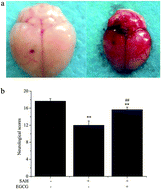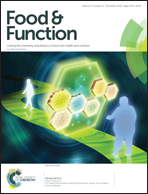Evaluation of the neuroprotective effect of EGCG: a potential mechanism of mitochondrial dysfunction and mitochondrial dynamics after subarachnoid hemorrhage
Abstract
(−)-Epigallocatechin-3-gallate (EGCG), the main bioactive component of tea catechins, exhibits broad-spectrum health efficacy against mitochondrial damage after subarachnoid hemorrhage (SAH). The mechanisms, however, are largely unknown. Here, the ability of EGCG to rescue mitochondrial dysfunction and mitochondrial dynamics following the inhibition of cell death was investigated by using in vitro and in vivo SAH models. EGCG blocked the cytosolic channel ([Ca2+])i influx via voltage-gated calcium channels (VGCCs), which induced mitochondrial dysfunction, including mitochondrial membrane potential depolarization and reactive oxygen species (ROS) release. As expected, EGCG ameliorated oxyhemoglobin (OxyHb)-induced impairment of mitochondrial dynamics by regulating the expression of Drp1, Fis1, OPA1, Mfn1, and Mfn2. As a result, EGCG restored the increases in fragmented mitochondria and the mtDNA copy number in the OxyHb group to almost the normal level after SAH. In addition, the normal autophagic flux induced by EGCG at both the initiation and formation stages regulated Atg5 and Beclin-1 after SAH for the timely elimination of damaged mitochondria. In the end, EGCG increased the neurological score by decreasing cell death through the cyt c-mediated intrinsic apoptotic pathway. The results revealed the mechanisms behind the neuroprotective effects of EGCG via inhibition of the overloaded [Ca2+]i-induced mitochondrial dysfunction and the imbalanced mitochondrial fusion and fission cycle. Therefore, the simultaneous inhibition and timely elimination of damaged mitochondria could determine the therapeutic effect of EGCG.



 Please wait while we load your content...
Please wait while we load your content...